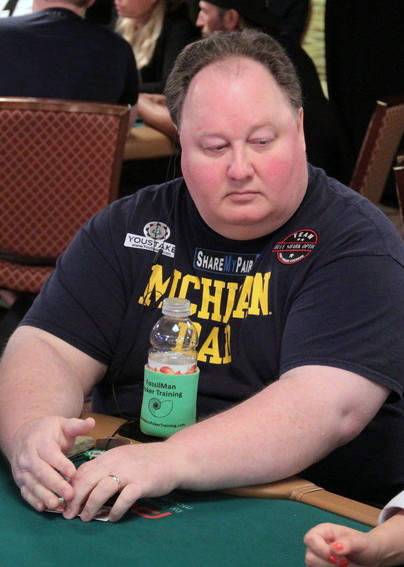






Poker Strategy With Greg Raymer: Properly Adjusting For Bounty TournamentsWSOP Main Event Champion Explains How To Calculate The Bounty At Each Stage Of A Tournament |
|
|
Card Player Magazine, available in print and online, covers poker strategy, poker news, online and casino poker, and poker legislation. Sign up today for a digital subscription to access more than 800 magazine issues and get 26 new issues per year!

Greg Raymer
@FossilMan, or send me a message at info@fossilmanpoker.com.
In chapter 37 of my book FossilMan’s Winning Tournament Strategies, I discuss how to adjust for several different non-standard tournament formats. I mention strategy changes for six-max events, turbo tournaments, shootout tournaments, and more. But the first format I discuss, and the one I enjoy the most, is the bounty tournament.
In a standard event, all the prize money is distributed to the winners who finish in the top 10-15 percent (or thereabouts). In a bounty event, a significant chunk of the entry fee is awarded to the person who knocks you out of the tournament, with the rest going to those who finish in the money.
For example, you might enter a standard $235 tournament, where $35 goes to the house, and $200 into the prize pool. But if this were a bounty tournament, it might be distributed $35 to the house, $150 into the prize pool, and $50 to the player who eliminates you. Of course, the ultimate winner doesn’t get eliminated, and gets to keep her $50 bounty, along with whatever money is paid to first place.
One reason I like bounty tournaments so much is that most players drastically under-adjust for the bounty, especially in the early levels. And yet I also see many players over-adjust for the bounty in the later stages. Properly adjusting for the bounty can be a tricky thing to do. But I’m here to offer you an easy shortcut to help you make this complicated adjustment with a high degree of accuracy.
My solution is to convert the value of a bounty into its chip equivalent. For example, in our tournament example above, $150 went into the prize pool and $50 went to the bounty. If this event had a starting stack of 15,000 chips, then 15,000 chips is equal in value to $150. If this is true, then $50 (the bounty) is equal in value to 5,000 chips. Therefore, the only adjustment you need to make is to assume there is an extra 5,000 chips in the pot if an opponent is all-in, and you have them covered.
Let’s look at this principle in practice. It is still level 1 in this event, with blinds of 100-100. A player at your table hasn’t been doing well, and is down to 2,500 chips. It folds to them on the button, and they go all-in. The small blind folds, and you are last to act. Should you call?
If this were a standard tournament, you would need to call 2,400 more to win 2,800, and would only call if you thought you had better than a 46 percent chance of winning. However, with a $50 bounty to be won, it still costs you 2,400 chips to call, but you will win 2,800 chips plus a bounty worth 5,000 chips.
Now, it becomes correct for you to call even if you think you only have a 24 percent chance of winning. And you will likely have an average equity here of well over 24 percent with any two cards, including your worst hands like 7-2 offsuit!
However, what I more often see is the player in the big blind calling with almost the same range of hands they would in a standard format tournament. They mostly ignore the bounty factor, and just play like they would in any other event when facing a shove for 25 big blinds. That is, they severely under-adjust for the bounty.
Yet, once we get deep in such a tournament, I see players do the opposite. Now we are at the final table, the average stack is now 200,000 chips, and the big blind is up to 5,000. Then, a short stack shoves for 40,000 chips, or eight big blinds. It folds to the big blind, who has a good stack of 300,000. They look down at a hand they would fold in a standard tournament, but decide to call because they can win a bounty, and feel like losing 40,000 chips won’t hurt them too much.
But now they are severely over-adjusting for the bounty. They were in a position where they had to call 35,000 more to win a pot of about 50,000 chips. Adding the value of the bounty to this pot only increases it to 55,000 chips. This clearly isn’t going to add all that many hands to the range with which they are correct to call.
 Use this shortcut, and before the tournament starts just calculate the chip equivalent value of a bounty. Then simply pretend there are that many more chips in the pot when making your decision. And for more details on how to adjust for a bounty event, look for my next column, and check out chapter 37 of my book! ♠
Use this shortcut, and before the tournament starts just calculate the chip equivalent value of a bounty. Then simply pretend there are that many more chips in the pot when making your decision. And for more details on how to adjust for a bounty event, look for my next column, and check out chapter 37 of my book! ♠
Greg Raymer is the 2004 World Series of Poker main event champion, winner of numerous major titles, and has more than $7 million in earnings. He recently authored FossilMan’s Winning Tournament Strategies, available from D&B Publishing, Amazon, and other retailers. He is sponsored by Blue Shark Optics, YouStake, and ShareMyPair. To contact Greg please tweet @FossilMan or visit his website.
